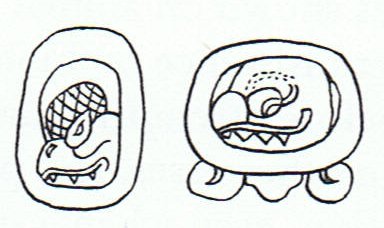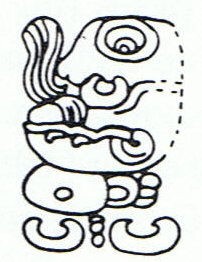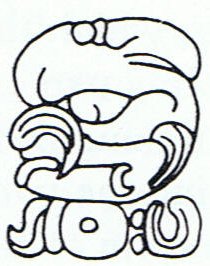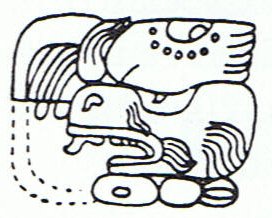The dark nights at the end of a cycle before a new cycle could begin were described both in positive ways, as when Nut was able to give birth, but apparently also as a sinister and life-threatening time. The mathematical operation to truncate (hew off) digits (e.g. with 3.14159 ... truncated into 3.14) could conveniently be illustrated as cutting of fingers (digits). I remember from my short but intensive Mayan studies a discussioin (in David Humiston Kelley's Deciphering the Maya Script) regarding the meaning of Zotz, the 4th month: "... Morley's remarkable idea that the patron of Zotz was the bat is an example of how easy it is to see what we expect to see. Since zotz means 'bat', he expected a bat ..."
"... the month called Zotz in Yucatec shows a head identifiable as that of a leaf-nosed bat, called zotz in Yucatec. Cognate forms in other languages show that this is an ancient word for 'bat' (Tzeltal sots' 'bat'; Manche Chol zutz' 'bat'; Palencano Chol and Chontal zutz' 'bat'; Huaxtec thut' 'bat'; Quiche zotz' 'bat' - the consonants all correspond regularly, but the vowel shift to -o- in Yucatec, Tzeltal, and Quiche is still unacounted for) ..." 
I can now guess why zotz was thought of as a bat who had a
'leaf-nose' - it could have meant that in front was the
'year in leaf'. Although the Mayan convention had the face
at left, as if in opposition to the face at right in
rongorongo writings. Maybe there was the rule to always face
the rising Sun.
"One of the discoveries which did the most to reopen some of the important questions about the nature of the Maya script was Thompson's (1944) demonstration of the great likelihood that xoc 'count' was represented in the inscriptions by the head of a large fish, the xoc or 'shark'. Substituting for this in many inscriptions was the hieroglyph T511, also found for the day Muluc. Since the xoc shark is a patron deity of the day Muluc, Thompson assumed that the xoc head was the head form of the muluc glyph.
Reasonable as this seems, it implies both a straightforward rebus use for xoc and a symbolic secondary meaning for muluc, which he apparently thinks should also be read xoc in this context, 'the symbol for water or rain representing the creature which inhabits water and in all probability gave rain to the earth' (Thompson 1950, p.163). This view neglects the fact that there is a perfectly good allograph or head variant of muluc, which is not the xoc fish, but rather the so-called kan dog. While the Yucatec day is named Muluc, equivalent days in the other languages are simply Mulu (or, in the highlands, Toh). The Quiche language seems to offer a clue to this labyrinth with the definition of mul as 'time, turn, rotation, revolution'. The counting of the year might easily appear in another context as the turning of the year ..." (Kelley)
The following were some of my remarks:
... North of the equator, among the Mayas, it could have been similar, with the 'shark' sign used for a kind of 'zero' where computational discrepancies were 'swallowed'. I remember having read (in David Humiston Kelley's Deciphering the Maya Script) that Mayan xoc means both shark, bat, and to count. Furthermore, in another dialect (Yucatec) xoc was zotz:
The open mouth could possibly illustrate how sky separates from earth in spring. The month Zotz was, I think, located not far from spring equinox ... ... The so called xoc fish imagined in the zotz glyph refers only to the one in the monumental form, I must conclude ... The monument glyph exemplifying Zotz has serpent's teeth, I can identify from these two Chicchan day name glyphs:
When illustrating the zotz (bat) Kelley gives also the following glyphs:
... The fish representing Zotz cannot be shuffled under the mat. Reading on in Kelley I have now been convinced the glyph really suggests a fish. The 'leaf-nose of the bat', which I thought resembled a flame, probably is intended to show a kind of fish fin. Three examples of xoc fishes in glyph compounds:
... Fishes thrive in water, birds in the air and the rest in between. When a xoc fish appears in the month of the bat (Zotz) ... it ought to represent a turbulent (mixed) month and the season who should leave is winter. Well, now. A fish 'with a very long nose' is found in Easter Island mythology. ... The dream soul went on and came to Tama. She named the place 'Tama', an evil fish (he ika kino) with a very long nose (he ihu roroa) ... A good description of Zotz, I think. ... Amazingly, xoc fishes are sharks! And according to Polynesian lore the chiefs are like sharks that walk on land! ... Here, in a very condensed form, is a typical Fijian myth of the origin of the current ruling clan (mataqali): A handsome, fair-skinned stranger, victim of an accident at sea, is befriended by a shark who carries him ashore on the south coast of Viti Levu. The stranger wanders into the interior where he is taken in by a local chieftain, whose daughter he eventually marries. From this union springs the line of Noikoro ruling chiefs, the narrator of the story being the tenth descendant on that line. He and his clansmen are called 'The Sharks' (Na Qio)... It is all as in the Hawaiian proverb: 'A chief is a shark that travels on land'... Somewhere I have read, I now seem to remember, that the English word 'shark' is derived from xoc. 'Thus I believe that Thompson's brilliant decipherment of xoc 'shark' for xoc 'count', which I fully accept, was overextended in the attempt to apply it to T511, which I think should be read simply as mul(u) ... To count the year beginning when sun reappears may be the reason for Zotz (Xoc) meaning both shark, bat and count. The limit is determined by the Pleiades, I guess ... ... In some mysterious way the dog is connected with Sirius, the announcer of a new year. In ancient Egypt the dog-star was also the announcer of land rising up again from the water (after the inundation caused by the Nile). It seems the concept had survived with the Aztecs. But the shark (Xoc) in some equally mysterious way is connected with the rise of land with the Polynesians - where a chief is like a shark who walks on land (at least according to the Hawaiian view). This shark is not Xoc but Cipatli, of course, who inhabits the 'roots of the world tree' (the Milky Way) ...
I think this conglomeration of baffling ideas will do for the moment. Although I must say that my previous remark that the English word 'shark' should derive from xoc, probably was wrong, because I have a faint memory of having read that 'shark' derives from a word for ray. If the fish of origin was not a shark but its cousin the manta, then the associations will be quite different:
| ||||||||||||||||||||||||||||||||||||||||||||||||||||||||||||||||||||||||||||||||||||||||||||||||||||||

























